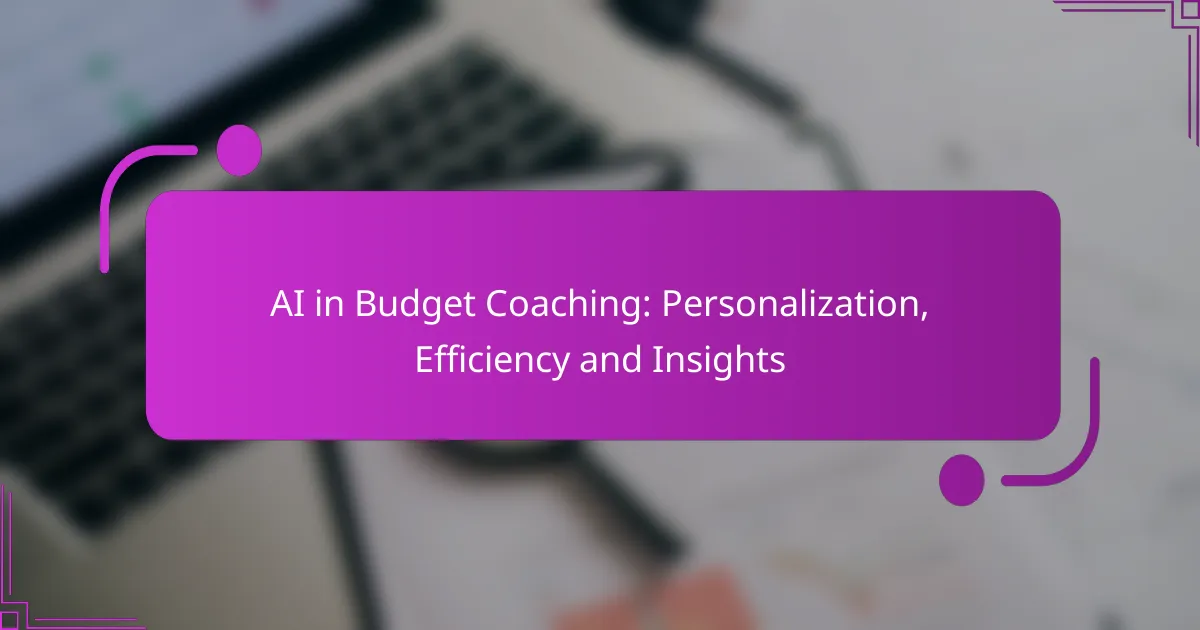AI is revolutionizing budget coaching by offering personalized financial guidance that enhances efficiency in expense tracking and provides valuable insights. By utilizing data analytics and machine learning, these tools empower individuals to make informed decisions about their spending and saving habits, ultimately transforming their financial management experience.

How does AI enhance budget coaching in the US?
AI enhances budget coaching in the US by providing tailored financial guidance, improving efficiency in tracking expenses, and delivering actionable insights. These advancements help individuals manage their finances more effectively and make informed decisions about their spending and saving habits.
Personalized financial plans
AI-driven budget coaching creates personalized financial plans by analyzing individual spending patterns and financial goals. This technology assesses income, expenses, and savings to tailor strategies that fit each user’s unique situation.
For example, a user aiming to save for a home can receive a customized plan that outlines specific savings targets and timelines. This level of personalization increases the likelihood of achieving financial objectives.
Real-time expense tracking
Real-time expense tracking powered by AI allows users to monitor their spending as it happens. By integrating with bank accounts and credit cards, AI tools categorize expenses automatically, providing immediate visibility into financial habits.
This feature helps users identify areas where they may overspend, enabling them to adjust their budgets on the fly. Regular notifications about spending limits can also encourage more mindful financial decisions.
Automated savings recommendations
AI systems can generate automated savings recommendations based on users’ financial behavior and goals. By analyzing transaction data, these tools suggest optimal amounts to save each month, often adjusting recommendations as income or expenses change.
For instance, if a user receives a bonus, the AI might recommend allocating a portion of that extra income toward savings or investments, ensuring that financial growth is prioritized.
Data-driven insights
Data-driven insights from AI enhance budget coaching by providing users with actionable information derived from their financial data. These insights can reveal spending trends, highlight potential savings opportunities, and forecast future financial scenarios.
Users can benefit from visual reports that illustrate their financial health over time, making it easier to understand where adjustments are needed. Regularly reviewing these insights can lead to more informed financial decisions and better overall money management.

What are the benefits of AI in budget coaching?
AI in budget coaching offers personalized insights, increased efficiency, and improved accuracy, transforming how individuals manage their finances. By leveraging data analytics and machine learning, AI tools can provide tailored recommendations that align with users’ financial goals.
Increased efficiency
AI significantly enhances efficiency in budget coaching by automating routine tasks such as expense tracking and categorization. This allows users to spend less time on manual entries and more time analyzing their financial health.
For example, AI-driven applications can quickly analyze spending patterns and generate reports within seconds, compared to traditional methods that may take hours. This time-saving aspect enables users to make timely financial decisions.
Improved accuracy
AI improves accuracy in budget coaching by minimizing human error in data entry and calculations. Advanced algorithms can analyze vast amounts of financial data to identify discrepancies and provide precise insights.
Users can expect higher fidelity in their budget forecasts, as AI tools continuously learn from user behavior and adapt their recommendations accordingly. This leads to more reliable financial planning and fewer unexpected expenses.
Enhanced user engagement
AI enhances user engagement by offering interactive and personalized experiences in budget coaching. Through chatbots and virtual assistants, users can receive real-time support and answers to their financial queries anytime.
Moreover, gamification features in AI applications can motivate users to stick to their budgets by rewarding them for achieving financial milestones. This engagement fosters a proactive approach to personal finance management, making it easier for users to stay on track with their goals.

Which AI tools are best for budget coaching?
Several AI tools excel in budget coaching by offering personalized insights, efficient tracking, and actionable recommendations. The best options include Mint, YNAB (You Need A Budget), and Personal Capital, each with unique features tailored to different financial needs.
Mint
Mint is a popular budgeting tool that aggregates financial accounts to provide a comprehensive view of your finances. It uses AI to categorize spending, track bills, and create budgets based on your spending habits.
One of Mint’s strengths is its user-friendly interface, which allows for quick setup and easy navigation. Users can set financial goals and receive alerts for unusual spending, helping to maintain budget discipline.
However, privacy concerns may arise since Mint requires access to bank account information. Ensure you are comfortable with their data security measures before using the app.
YNAB (You Need A Budget)
YNAB is designed around a proactive budgeting philosophy that encourages users to assign every dollar a job. Its AI features help analyze spending patterns and suggest adjustments to meet financial goals.
This tool is particularly effective for those looking to break the paycheck-to-paycheck cycle. YNAB offers educational resources and community support, making it ideal for users wanting to improve their financial literacy.
While YNAB requires a subscription fee, many users find the investment worthwhile for the level of control and insight it provides. Consider a free trial to see if it aligns with your budgeting style.
Personal Capital
Personal Capital combines budgeting with investment tracking, making it suitable for users focused on long-term financial planning. Its AI analyzes spending and investment performance, offering insights into net worth and retirement planning.
This tool is beneficial for users with diverse financial portfolios, as it provides a holistic view of both daily expenses and long-term investments. The dashboard is intuitive, allowing for easy monitoring of financial health.
While Personal Capital is free, it also offers wealth management services for a fee. Users should weigh the benefits of professional advice against their financial needs before opting for these services.

How to choose the right AI budget coaching tool?
Choosing the right AI budget coaching tool involves evaluating its user interface, pricing models, and integration capabilities. These factors will help ensure that the tool meets your financial management needs effectively and efficiently.
Assess user interface
The user interface (UI) of an AI budget coaching tool is crucial for ease of use. A clean, intuitive design allows users to navigate the tool effortlessly, making it easier to track expenses and set budgets. Look for features like customizable dashboards and clear visualizations that enhance user experience.
Consider testing the UI through demos or free trials. This hands-on approach can reveal how well the tool aligns with your preferences and whether it simplifies your budgeting process.
Evaluate pricing models
Pricing models for AI budget coaching tools can vary widely, from subscription-based to one-time fees. Assess what fits your budget by comparing monthly and annual costs, as well as any additional fees for premium features. Many tools offer tiered pricing, which can provide flexibility based on your financial needs.
Be cautious of hidden costs, such as charges for data storage or customer support. A transparent pricing structure will help you avoid unexpected expenses and ensure you get value for your investment.
Consider integration capabilities
Integration capabilities are essential for seamless financial management. Check if the AI budget coaching tool can connect with your existing financial accounts, such as bank accounts and payment platforms. This connectivity allows for automatic data updates, reducing manual entry and improving accuracy.
Look for tools that support popular accounting software or financial apps. This compatibility can enhance your budgeting experience by consolidating all financial information in one place, making it easier to analyze your spending habits and adjust your budget accordingly.

What are common challenges in AI budget coaching?
AI budget coaching faces several challenges that can hinder its effectiveness. Key issues include data privacy concerns, the need for accurate data input, and the potential for algorithmic bias, all of which can impact user trust and the quality of financial advice provided.
Data privacy concerns
Data privacy is a significant challenge in AI budget coaching, as users often share sensitive financial information. Ensuring that this data is securely stored and processed is crucial to maintain user trust and comply with regulations such as GDPR in Europe or CCPA in California.
To address these concerns, AI budget coaching platforms should implement strong encryption methods and transparent data usage policies. Users should be informed about how their data will be used and have the option to opt-out of data sharing.
Additionally, regular audits and compliance checks can help ensure that data privacy measures are effective. Users should look for platforms that prioritize data security and offer clear privacy terms to safeguard their financial information.



